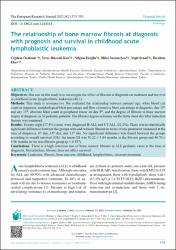The relationship of bone marrow fibrosis at diagnosis with prognosis and survival in childhood acute lymphoblastic leukemia
Künye
Özdemir, Ç., Kar, Y. D., Eroğlu, N., Şen, H. S., ŞENOL, Y., & İbrahim, E. K. E. R. (2023). The relationship of bone marrow fibrosis at diagnosis with prognosis and survival in childhood acute lymphoblastic leukemia. The European Research Journal, 9(2), 375-383.Özet
Objectives: Our aim in this study is to investigate the effect of fibrosis at diagnosis on treatment and survival in childhood acute lymphoblastic leukemia (ALL). Methods: This study is retrospective. We evaluated the relationship between patients' age, white blood cell count at diagnosis, morphological blast percentage and flow cytometric blast percentage at diagnosis, day 15th and day 33th, absolute blast count in peripheral smear on day 8th, and the degree of fibrosis in bone marrow biopsy at diagnosis in 36 pediatric patients. The fibrosis degree in biopsy on the thirty-third day after induction therapy was measured. Results: Twenty-eight (77.8%) cases were diagnosed B-ALL and 8 T-ALL (22.2%). There was no statistically significant difference between the groups with and without fibrosis in terms of any parameter measured at the time of diagnosis, 8th day, 15th day, and 33th day. No significant difference was found between the groups according to overall survival (OS): the mean OS was 50.22 ± 5.44 months in the fibrosis group and 49.70 ± 3.96 months in the non-fibrosis group (p = 0.557). Conclusions: There is a high detection rate of bone marrow fibrosis in ALL pediatric cases at the time of diagnosis. Nevertheless, fibrosis does not affect survival.
















